The Spy’s Daughter

I’m very pleased to welcome historical fiction author Tony Riches as a guest to my blog today.
Tony is an author of best-selling historical fiction. He lives in Pembrokeshire, West Wales and is a specialist in the history of the Wars of the Roses and the lives of the Tudors. He is best known for his Tudor trilogy, and is now completing his Elizabethan series.
He runs a popular podcast series, Stories of the Tudors.
His new novel, Frances: Tudor Countess, has just been published. Based on extensive research, original letters and records of the Elizabethan Court, this new account explores the life of Frances Walsingham, the only surviving child of Queen Elizabeth’s ‘spymaster’ Sir Francis Walsingham.
Better educated than most men, her father arranges her marriage to warrior poet Sir Philip Sidney. After Philip is killed in battle, Frances becomes Countess of Essex, and is banished from court after her second husband Sir Robert Devereaux’s rebellion against the queen. In her third marriage, can she marry for love, if it means turning her back on her faith and all she knows?
The story follows Frances, Countess of Essex and Clanricarde, from her first days at the Elizabethan court to the end of the Tudor dynasty and the rise of the Stuarts.
I interviewed Tony about his new book:
Why did you choose to write about Frances?
I decided to make the Elizabethan books a series of six, rather than a trilogy, and explore the complexity of Queen Elizabeth through the eyes of three of her favourite men, Drake, Essex and Raleigh, and three of her ladies. I had plenty of ladies to choose from, but found the most interesting were Penelope, eldest daughter of the queen’s nemesis, Lady Lettice Knollys, one of her ‘gentlewomen’, Bess Raleigh, and Frances, the only surviving child of the queen’s spymaster, Sir Francis Walsingham.
I had already researched Frances when writing my book about her second husband, Robert Devereux, Earl of Essex, and was intrigued to learn Frances nursed her father through illness at his home, Walsingham House, in the shadow of the Tower of London. Unusually for the time, Sir Francis ensured his daughter had the best education he could afford, and spent long hours tutoring her himself in Latin, French and Spanish.
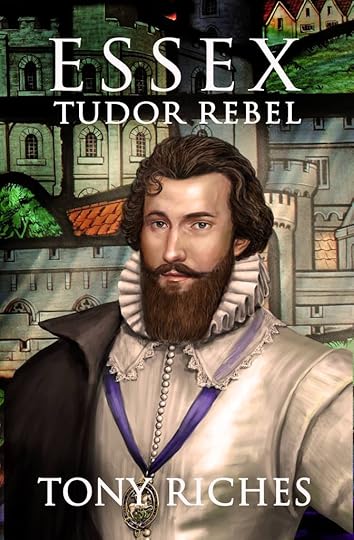
Can you tell us something about how and where you do your research for your novels and for this one in particular?
Over the past ten years I’ve built an extensive reference collection of books on everything Tudor and Elizabethan, from medicine to recipes, childbirth to government, as well as numerous biographies of key players in the story of the Tudors. All this research provides the backdrop within which the real lives and relationships of my chosen subjects develop and evolve.
One of my favourite historical sources for the Elizabethan series is The Elizabethan Court Day by Day by Marion E. Colthorpe.
A rich and varied collection of research, this is where I discovered such details as the queen’s chambers being infested with fleas, the lists of participants in Accession Day jousts, and actual menus for royal banquets. Most importantly, this resource enabled me to cross-check events on any day at the Elizabethan court with other sources to ensure historical accuracy.
How did her father’s career as ‘spymaster’ affect her? Did she have anything of the spy in her?
The queen was unsympathetic about her spymaster’s illness, and concerned about Catholic plots. His problem was knowing who he could trust, as he even suspected members of his own network of being double agents. It is therefore likely that he would turn to the one person he could rely on, his daughter Frances.
In my book, Frances works in her father’s study, decoding the latest letters of intelligence from their agents. The work takes patience, yet she finds the challenge satisfying. Her ability to memorise and recall the detail of codes means she can decipher faster than her father. She enjoys helping him, and being the first to know important state secrets.
She was married to two fascinating men Philip Sidney and Robert Devereaux. Can you tell us something about those relationships?
Her father arranged her marriage to Philip Sidney, and paid off his debts, so he must have seen something in the warrior poet (who was in love with Frances’ friend, the beautiful, charismatic and wealthy Baroness Penelope Rich, the subject of my previous book).
Robert Devereux had his pick of the wealthy heiresses at court, yet chose to marry Frances. We can never know for certain, but I suspect Robert promised the dying Philip, his best friend and mentor, that he would take good care of his wife and young daughter Elizabeth.
Are any of Sidney’s poems inspired by Frances?
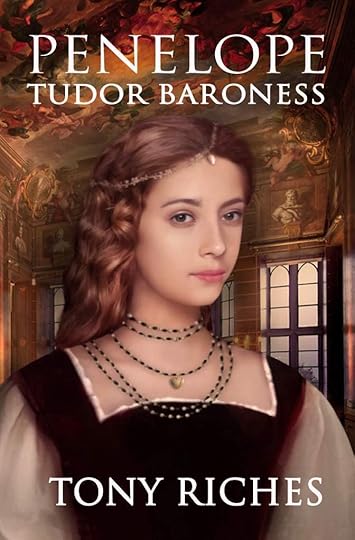
I studied Philip Sidney’s poetry in hope of finding something about Frances, but it must have been evident to her that the subject of her husband’s poetry was his ‘Stella’, his code name for Penelope Rich. Frances was a realist, and remained a lifelong friend to Penelope (who became her sister-in-law when Frances married Robert Devereux).
Any other fascinating elements of the novel you’d like to mention for us?
An unexpected development comes after the Essex rebellion, when Frances meets her third husband and becomes an Irish countess. I’d studied the English occupation of Ireland for previous books in the Elizabethan series, but found it interesting to look at events from the Irish point of view.
Frances could have remained at her mansion in London or her new estate in Kent, but chose to live with her family in the draughty castle in Athlone to be close to her husband, who’d been made governor of Connaught. I created the character of Orla Ryan, the bright young daughter of a prosperous Galway merchant, to represent the local servants Frances would have employed, and from whom she learns about the Irish language and culture.
Are there any particular sites or artefacts that you used in your writing to conjure up your story?
I tracked down examples of the ciphers Frances could have worked on:
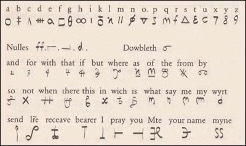
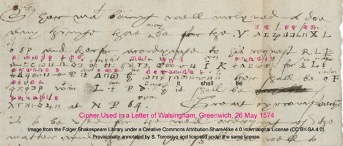
Frances could have helped her father decode letters from Mary Queen of Scots, and provide evidence of the Babington plot, as well as the first warnings of the Spanish Armada. Unlike the substitution tables favoured by Catholics, her father used symbols, over and under the same letters, to change their meaning. For example, a letter ‘m’ with two dots below means ‘more’, and ‘m’ with a bar across the top means ‘money’. The queen and many others had their own secret symbols, meaningful only to Frances, her father and his most trusted agents.
I also found a painting by J M W Turner of the mansion house at Somerhill, in Tonbridge, Kent, which was built for Frances by her third husband:
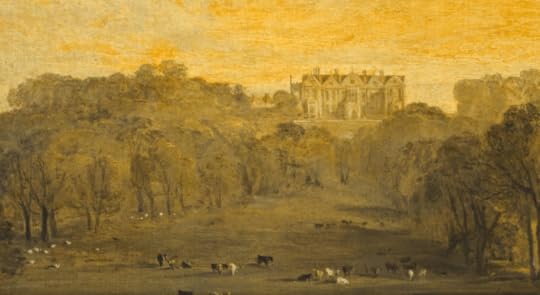 Somerhill by J M W Turner (Creative Commons)
Somerhill by J M W Turner (Creative Commons)Somerhill is now a private school, but as well as original architectural details, Turner’s painting was invaluable for understanding how the building dominated the landscape. I also found the original plans for Portumna Castle in Ireland, which helped make it an authentic setting for events in the book.
What’s next for you?
I am now working on the research for the sixth and final book in the Elizabethan series, about another underestimated woman, Bess Raleigh. When I set out on this ‘journey’ to tell the story of the Tudors I had no idea how much I would learn about fascinating women, such as Frances Walsingham, who witnessed the key events of the Elizabethan era first-hand, yet is so little known – until now.
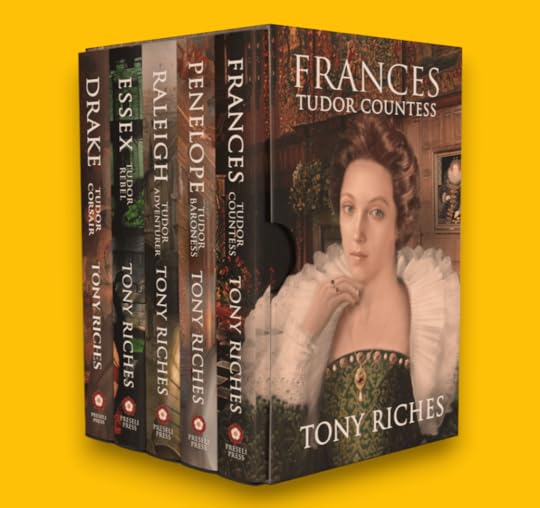
Thank you very much for talking with me, Tony, and for bringing these characters from history so vividly to life for readers.
Frances – Tudor Countess is new from Amazon in eBook and Paperback, and an audiobook edition will be produced this year:
 https://www.amazon.co.uk/dp/B0D1YQYL8
https://www.amazon.co.uk/dp/B0D1YQYL8
 https://www.amazon.com/dp/B0D1YQYL8G
https://www.amazon.com/dp/B0D1YQYL8G
Links:
Website: https://www.tonyriches.com/
Twitter: https://twitter.com/tonyriches
Bluesky: https://bsky.app/profile/tonyriches.bsky.social
Facebook: https://www.facebook.com/tonyriches.author/
LinkedIn: https://www.linkedin.com/in/tonyriches/
Instagram: https://www.instagram.com/tonyriches.author/
Amazon Author Page: https://www.amazon.com/Tony-Riches/e/B006UZWOXA
Goodreads: https://www.goodreads.com/author/show/5604088.Tony_Riches



